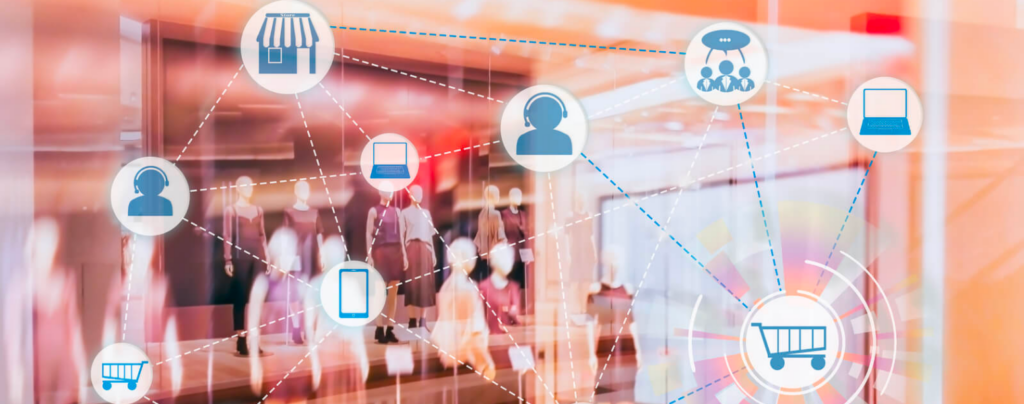We use cookies to improve your experience. By continuing to use this website you agree to our cookie policy.
Imagine a world where no matter where your customers meet your brand, whether online or offline, you have the power to affect their buying decision-making. With an omnichannel retail strategy, brands no longer have to imagine that world.

Omnichannel retail is a fully-integrated approach to commerce, supplying shoppers a unified experience across all channels or touchpoints by providing brands with a cohesive presence, whether in the physical store, social media channel, a virtual shopping experience or the Metaverse.
Keeping a robust and cohesive omnichannel presence can be confusing. Nevertheless, luxury brands have jumped headfirst into what omnichannel brings to a business. At the dawn of a digital-shopping era, luxury brands were determined to remain exclusive and offline, attaching themselves to brick and mortar; however, one-third of all personal luxury purchases will take place digitally by 2025, with those revenues acquiring an estimated $136 billion, according to Bain & Co., which means that brands can longer afford to ignore their online presence.
Studies reported that businesses with omnichannel-solid strategies keep an average of 89% of their customers and see a 9.5% year-over-year increase in annual revenue.

The luxury of ‘phygital’
Recently, luxury brands at London Fashion Week (LFW) have taken social media and other digital measures to combine the event with online shopping possibilities. Instagram has predominantly evolved as a hugely effective tool for pushing online and physical luxury goods sales.
During LFW alone, back in February 2018, the official event’s Instagram account received a total of 871,648 Story views, exposing brands to a massive array of potential customers, according to Tech HQ.
Gucci is a luxury fashion brand that has embraced digital.
Recently, the label has reworked its website to deliver better, eye-pleasing visuals in a quest to amuse their audience through frequent posting on social media and have also streamed fashion shows using Facebook Live.
According to Tech HQ, the brand has earned its digital points, with its revenue rising 42 percent in 2017.

Keeping up with the younger generation
Seeing as Gen Z and Millennials represent more than 40% of the overall luxury goods market, it’s a no-brainer why brands want to get in front of them in all forms they can find. To keep in the loop of a younger demographic, it’s vital to be active and engaging on Instagram, which is why brands such as Louis Vuitton and Balenciaga tell a brand story while keeping their aesthetic very clear and distinctive to the online consumer.
In 2018, Gucci presented a unique digital campaign featuring scannable ads and augmented and virtual reality. Stamped as Gucci Hallucination, according to Statistica, the campaign recorded an expansion of 24.9% in revenue that year, achieving the highest rise in eight years.
Why Omnichannel Cohesion is Important to Luxury Brands
Luxury customers desire a seamless and unique experience when interacting with a brand. This means walking into a captivating store and participating in a memorable and striking experience online. According to Merkle’s Experience Impact report, 66% of customers care more about the experience than about product or service price. Further, the behaviour study conveyed that 52% would stop shopping on a brand’s website due to a bad site experience.
In Future by retail operations: winning in a digital era by McKinsey & Company, it has been said that for retailers to stay feasible in this setting, they must continuously enhance their store economics by streamlining, eliminating, or automating routine activities.
Customers are looking for brands to meet their needs in the most efficient and personal way possible. Adrien Nussenbaum, co-founder and U.S. CEO, Mirakl, said, “Every retailer needs a strong grasp on marketplace strategies to compete in today’s digital-first economy.”
The Funnel
For luxury consumers, it’s essential to be taken through a funnel that makes sense while striving to amuse them with an added value. Luxury brands can take control of their customer needs and create a seamless experience throughout an efficient customer journey.
For example, a customer would discover a luxury item online and purchase it. They will then receive a branded package that gives them a perspective into the brand’s values. Later down the line, the customer will be met by retargeting ads offering products from the same brand that could compliment the product they previously bought.
After the second purchase, the customer receives an email revealing a nearby retail store location or an exclusive event. This has the potential of translating into a social media experience for the customer, leading them to share events, store locations and brand engagement across channels.

The monumental transformation of online shopping persists through even post- lockdown, and brands continue looking into advanced ways to improve product discovery and increase sales. Thus, omnichannel is what consumers are looking for, which will evolve as an industry benchmark for luxury brands.
Find out more about an omnichannel solution in another article here.
